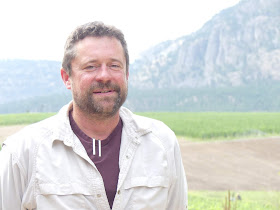Photo: Winemaker and vineyard manager Ryan McKillop (courtesy Township 7)
Now celebrating its 19th anniversary, Township 7
Vineyards & Winery time in the industry has spanned the (so far) golden age
of British Columbia wine.
When the original Township 7 winery opened in Langley in 2001,
the VQA program was barely a decade old and still contentious; and there were
perhaps 50 wineries.
Today, there are 350 wineries with so many under development
that 400 is possible. The VQA program now is mature while a series of new sub-appellations
are drilling down to an understanding of terroir wines barely contemplated 20
years ago.
Township 7 consists of two of those wineries. The initial
winery in Langley is now dedicated to the production of sparkling wines. The
much larger winery at the start of the Naramata Bench makes a full range of
table wines.
There have been three sets of owners at Township 7 and each
has been better resourced. Businessman Ge Song,
who acquired the winery in 2014, has made major investments to expand the Okanagan
winery and upgrade the equipment. In 2018, he allowed the winery to purchase
the 12-acre Blue Terrace Vineyard near Oliver, securing total control over a vineyard
from which Township 7 has been buying fruit almost from the beginning.
He also has supported the winery in
critical personnel decisions. Mary McDermott, a skilled winemaker, was recruited
from Andrew Peller Ltd. in Ontario. She has had a major impact on the quality
of wines. And it was her idea to devote the Langley vineyard to sparkling
wines.
This summer, Township 7 added bench
strength by hiring Ryan McKibbon as assistant winemaker and vineyard manager. He
is a graduate of Niagara College’s Winery and Viticulture program. His expertise
includes organic and biodynamic grape growing.
He did a vineyard internship
focussed on organic and biodynamic viticulture at Felton Road Wines in New
Zealand. He has worked with other organic/biodynamic producers including Hidden
Bench Winery on Ontario, Crystallum Wines in South Africa and Phantom Creek in
the Okanagan.
Would anyone care to guess on the future
direction of Township 7’s viticulture?
The Township 7 journey illustrates why
British Columbia wines have improved so dramatically over the past 20 years:
better equipped wineries, more experienced winemakers and, most fundamentally,
much improved viticulture.
Current releases have benefited for
all that.
Township 7 2018 7 Blanc ($18.97
for 888 cases). This is a blend of 56% Gewürztraminer, 22% Pinot Gris, 9%
Viognier, 9% Riesling and 4% Muscat. All the varieties were fermented slowly at
about 12◦C over three weeks to deliver maximum freshness and flavour. The
aromas are predictably, and pleasantly, aromatic with notes of grapefruit and
spice. On the palate there are luscious flavours of pink grapefruit and
nectarine. The residual sugar adds to the lush texture and lingering finish.
91.
Township 7 2018 Sauvignon Blanc ($18.97
for 828 cases). The grapes for this wine are from the Blue Terrace Vineyard
near Oliver. Long a supplier of fruit to Township 7. Most of the fruit was
fermented cool in stainless steel; a two-barrel portion was fermented in oak
and added to the blend for complexity. The wine begins with aromas of lime
mingled with herbs. Crisp and dry on the palate, the wine delivers flavours of
lime, grapefruit zest and herbs. The finish is very persistent. 91.
Township 7 2018 Reserve Pinot Gris ($26.97
for 148 cases). The wine is exclusive to Township 7’s wine club. The wine
begins with aromas of pears and stone fruit. Rich in texture but with a dry
finish, the wine delivers flavours of pear and nectarine mingled with a hint of
orange and oak. The wine was barrel-fermented in neutral French oak. Lees
stirring added to fullness of the texture. The finish of this delicious and
complex wine lingers. 93.
Township 7 2016 Reserve Cabernet Franc ($45.97
for 198 cases). This wine is also a wine club exclusive. The fruit for this
wine came from the Romar Vineyard in Osoyoos. The wine was aged 24 months in
French oak (60%) and American oak. Dark in colour, the wine begins with very
expressive aromas of cherry, blackberry and cloves that explode from the glass.
On the palate, the wine has silky tannins and delivers flavours of black
cherry, blackberry, tobacco and spice. 93.







































